favicongohere
Please use the navigation menu at bottom the Page
MenuGoHere




“Winter Birding”
2014 Activities at Amherst State Park


Walk and Talk" series - February 16, 2014 "Winter Birding" - Morgan Jones, Ornithologist

The birders listen to Morgan Jones, as we start our walk.

Morgan points out sapsucker holes in a tree.

There just might be a Screech Owl
in that hole.

The group pays close attention.


Possibly the resident Red-Tail nest.
Ellicott Creek is just beautiful in the winter.

Alongside the creek and through the woods,
a-birding we shall go.


Mergansers normally are shore birds and it was
unusual to see the pair in Ellicott Creek.
It was afternoon and snowing, but Morgan finally spotted a bird. A Red-Breasted Merganser pair. This one is looking for fish. He was thrilled as this bird went on
his "Life List". It was the first time he had seen a
Red-Breasted Merganser.
I was using my little Canon Sure Shot and they were on the other side of the creek. Glad I was able to get at least one good shot. By the way, they have a beautiful red eye.


Walk organizer, Roselyn Laub, points to woodpecker holes in the tree.

Guess the lower apartment got too small.

The squirrels have been hungry. Morgan shows us a branch with bark chewed off.

As we headed back we passed several cross-country skiers.
Amherst State park is ranked #2 in Western New York for Cross-Country Skiing. We had a wonderful time. Thanks Morgan.

“Nature Through the Lens”
Robert Carey, President of the Buffalo Museum of Science Photography Club, leads a group of 20+ photographers for the Sunday "Walk and Talk" series at Amherst State Park. The topic was "Nature Through the Lens". It was only 20 degrees, but we all had a fun time.








Don't forget to look up. Robert found a "sapcicle", frozen sap, hanging from a tree.
Another great way to spend a winter day in Amherst State Park.
And don't forget to look down. Ice formations in the creek.
The bright colors of winter coats.
Robert leads the group along Ellicott Creek
Robert makes a point about selecting a scenic location.
Robert makes a point about selecting a scenic location.
“Arbor Day Tree Planting”

In celebration of Arbor Day 2014, and as part of the beautification project at Amherst State Park, now known as "The Gardens at Amherst State Park", thirteen "Prairie Fire" Crab Apple trees were recently planted in the triangular area at the end of the entrance driveway. Many thanks to the Amherst Town Board for funding the planting of these trees to complete this portion of the Gardens Project.

The landscapers begin planting the trees.


Got to get the soil just right.
Compost helps provide nutrients
for the young trees.




The "Triangle Area" shown relative to the Mother House.
Staking the trees.
One final tree was planted behind the front wall - a "Black Gum" tree which
will provide beautiful color in the fall.
The finished project. This year the tree planted four years ago, which is behind the light pole, is just beautiful.

“Wildflower Walk and Talk”


The group of participants gathered on Sunday April 27 for our final "Sunday Walks and Talks" program in this series. The walkers listen attentively to our talk leader Joanne Schlegel, before heading off.
Our Wildflower "Walk and Talk" leader, Joanne Schlegel is in the purple jacket near the front of the line. It was wonderful to have so many participants. About 30+ attended. Watch for announcements of future "Sunday Walks and Talks" programs at Amherst State Park.
The planting was planned to coincide with this year's celebration of Arbor Day and the presentation by the DEC of a flag and certificate designating the Town of Amherst as "Tree City USA 2013". The flag will be flown at Town Hall.
Four years ago the first tree of the beautification project at the park, a "Prairie Fire" Crab Apple tree, was planted on Arbor Day. The addition of the 13 trees now completes the landscaping of that area. In the future when these trees bloom in the spring, a beautiful burst of deep pink blooms will greet visitors to the park.

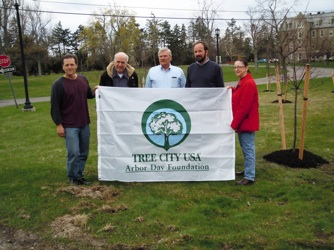

“Tree Wrapping Project”




Finishing the last tree. All in all, eleven trees were wrapped to protect against beaver damage. ACAC members and volunteers will continue to wrap trees as part of the ongoing project.
Team work gets the job done.
It was tricky work along the creek.
On June 12, 2014, as part of the Beaver Damage Control Project, Jared Sedor, Mike Procknal, and Peter Gajwka
work in the rain to install the protective fencing.
TREE WRAPPING PROJECT
Sponsored by the Amherst Conservation Advisory Council
Due to beaver damage in Amherst State Park along Ellicott Creek, the New York State Department of Environmental Conservation has recommended to the Amherst Conservation Advisory Council that an experimental program be initiated to wrap specific hardwood trees along the creek with fencing in an attempt to prevent future damage.
Please leave the fencing in place. Thank you for your cooperation.
Amherst Conservation Advisory Council | 5583 Main Street | Williamsville, NY 14221











The group begins to arrive for the first in the series of Amherst State Park "Walk and Talk" events. Our first event, "Tracks and Traces" was led by Naturalist Mary Hughes, second from the left.
Program coordinator, Roselyn Laub, is at right.
Mary explains how to identify animal tracks,
chews and rubs, and scat.
Mary explains various
animal foot prints.
The group checks a crabapple tree
for evidence of deer nibbling.
A deer left an imprint beneath an apple tree while bedded down.
Hardy naturalists are joined by dog walkers.
Heading back to our cars after a fun
and educational time at the park.
“Tracks and Traces”

The week of July 25-29 the was spent laying weed barrier and wood chips on the garden behind the front wall. This should help keep the weeds down and make maintenance easier. While the chips were being spread, the entire load of compost was moved to the North Garden forming a new border along the garden. We have 5 garden areas at park to maintain - the three "Entrance Gardens" in front of the wall, the landscaped area behind the wall, and "The North Garden". Community volunteers are always welcome to help out.
You can contact anherstarboretum@roadrunner.com to offer your services and receive information.
Weeded and ready to go.
The Amherst Highway Department and Parks Department provided wood chips and compost for the project. Weed barrier was laid down and the chips were spread over the barrier.
Making good progress. This was a big project for Ellen,
Karen and Lois, but we got the job done.
Meanwhile, Jerry was busy moving the load of compost to the North Garden to create a fresh border along the length. This was another big job
but it looks beautiful.
Almost done with the wood chips. It was a very good
feeling to have the rear garden done and a new edge
on the North Garden.
As the flowers in the Front Gardens were going to seed, Jerry and I decided to experiment with transplanting some Black Eyed Susans to the slope area. The plan is to eventually create a native plants area in that location. About a week after this, one of the volunteers donated some native asters that she and I planted. We will just have to see if any of them return.
Later that day, a beautiful dragonfly visited one of the White Pine trees.
Saturday October 11, 2014 was a special day at the park. 20 students and their Advisor, Jennifer Gorski, spent the morning winterizing the Front Gardens. They not only did an excellent job of weeding and cutting back the perennials, but then they planted 950 bulbs for spring blooms. A couple of hundred bulbs went into the North Garden and the rest were planted in the front. They should make a lovely splash of color come spring.
The students organized into teams and away
they went. Being in a garden was a new
experience for many of them.
Of course there was a little confusion at times.
Yes, they worked very hard and this was the result
of their effort. THANK YOU Daemen students.
While this website is dedicated to Amherst State Park, another group of students from Daemen College helped open a secondary trail at Nature View Park the morning of Sunday October 19. They worked very hard and the trail may now be used for hiking and Cross-Country skiing. A big THANK YOU to the students and their advisor, Rebecca Romano Besch.
July 18 and 19, 2014 - YES (Youth Engaged in Service) Students spread wood chips and plant shrubs at "The Gardens at Amherst State Park". "The Gardens" were formerly known as "The Arboretum". Many thanks to the Amherst YES students.
The students filled tub after tub of wood
chips to spread around the evergreens.
They raked up every little bit.
The hibiscus, hydrangeas and grasses
looked beautiful when they were finished.
Early September a Monarch Butterfly was spotted by a volunteer who was weeding one of the the Entrance Gardens. The butterfly flitted around for several minutes always returning to the same cone flower blossom. He called to me (Lois) the the butterfly had a white spot on its wing. Sure enough, it was a "tagged" Monarch. Each year, Monarch butterflies are raised by individuals who tag and release them for scientific purposes. This particular individual had been released two weeks earlier about 2 1/2 miles from the park. The program is run through Kansas University which is located in one of the Monarch flyways used on their migration to Mexico. It is very possibly that this male will spend the winter in a pine tree in Mexico.
The two small dots on the underwings (the rear wings) of the Monarch shown below indicate this is a male Monarch.
There is concern the Monarchs may become extinct due to habitat loss and two extremely cold winters at their winter homes in Mexico. The caterpillars eat milkweed leaves. It is their only source of food and with habitat destruction, the milkweeds are becoming less and less. The butterflies drink nectar from a variety of flowers including milkweed blooms. If you have milkweeds growing, let them be. They will attract Monarchs to lay their eggs. I hope to get more milkweed plants growing at the park to provide food for them.
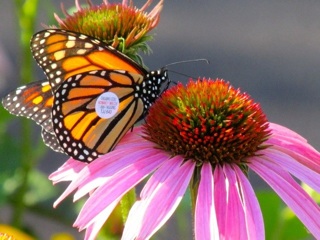



Planting on the Slope
Daemen Students at Amherst State Park
2014 Activities at Nature View Park
Monarch Butterfly













“Town of Amherst YES Students Gardening & Planting”

“Weed Barrier, Wood Chips and Compost”



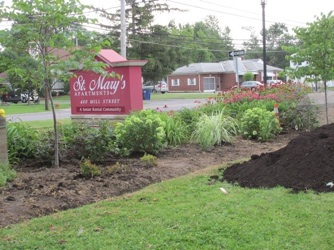






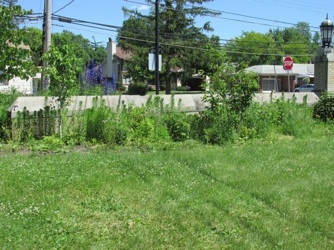
The YES students learned how to plant shrubs.
They were wonderful to work with and did a great job.
Before the YES students arrived to help out, the area needed to be cleared of lots of weeds. Volunteers from "The Gardens at Amherst State Park" committee got the job done.

“Second Tree Wrapping Project”

“Varied Habitats of Amherst State Park”
Nest of a Baltimore Oriole hanging
in a tree near the creek.
As we cross the creek, the view opens to a
meadow habitat, and further to the south (left)
is a wetland environment.
Across the meadow, a Blue Jay attacks a Red Tail Hawk.
The milkweed is a very important plant in the environment because it is the only source of food for the Monarch caterpillar. Gardeners are encouraged to plant milkweed to help preserve the Monarch Butterfly species.
Sunday Walk and Talk Series - October 26, 2014 - "Varied Habitats of Amherst State Park" Approximately 40 participants including Mrs. Theresa Corrigan's Nature Club from North Forest Elementary, enjoyed the walk led by Jajean Rose-Burney, Development Director for the Western NY Land Conservancy.
The students paid close attention
and were anxious to get started.
Jajean answers a students question.
And away we go. This is the Orchard Area
and home to a variety of bird species.
The Ellicott Creek Riparian Corridor - referring
to the creek and bank area 50 feet either side of the
creek, is home to a variety of birds, fish and aquatic life.









Every body gathers for the
start of the Walk and Talk.

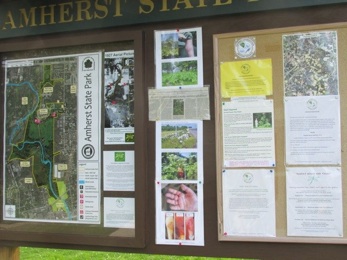


After three years the Amherst State Park Information Kiosk has finally been completed and is providing park information and a park map for visitors.
Thank you, Jerry, for the wonderful job you did on developing the kiosk. The many of hours spent stabilizing the structure, designing and installing the panel cases, and the preparing the information included in them has been much appreciated by fellow volunteers and visitors to the park. It is welcome addition to the enhancement of the park. Thank you.
Moving right along with the front side.
Front side done. Environmental topics and
upcoming events are posted on the front.
Rear side of the Kiosk.
One of the informative panels on the rear side of the Kiosk.


Park Information Kiosk
Installing one of the Plexiglass panels on the rear side.
North garden signs and bike rack

Two signs were constructed and placed in the North Garden acknowledging the work of community volunteers to plant and maintain the gardens.
Thanks to the Amherst Highway Department,
we now have a bike rack at the park.
October 12 brought out the tree wrappers from the Amherst Conservation Advisory Council. Good weather and a pleasant temperature made the workers very happy. Ten trees were wrapped making a total of 22 trees wrapped this year. This is an ongoing project and we will continue wrapping specified trees against beaver damage.
Jared, Mike, Conn and Pete are all
experienced tree wrappers now.
Get the edges lined up perfectly.
Not sure what tree this is, but it still had
beautiful tiny flowers in late October.
A happy crew prepares to move on to another tree.
Thanks everyone.

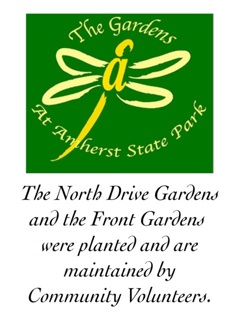


A Fawn in the Orchard



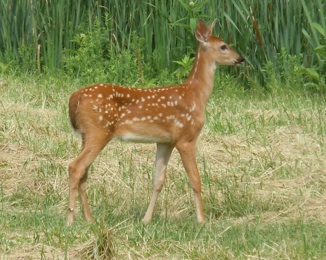




On July 9th I went down the maintenance road to check on the new Apple trees that were planted last year. As I approached one of the Apple trees, a fawn who was hiding in the tall grass around the base to the tree was started and took off towards the drainage swale. I got out my camera and took some pictures of him as he checked me out. He then slowly moved down the trail until he got near to road dividing the Orchard. As he neared the road he took off to go find his mother in the other side of the Orchard.









